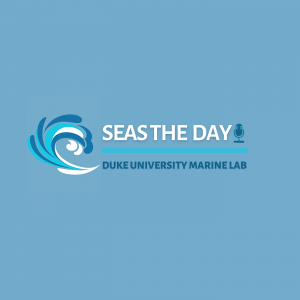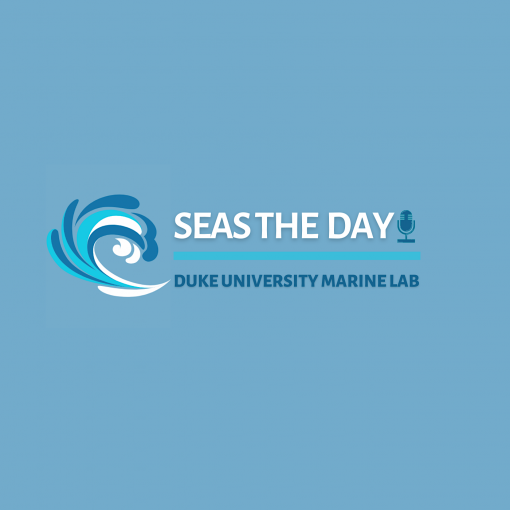This week’s episode focuses on the Taiwanese white dolphin. It was produced by Duke undergraduate students Pavel Pivarshev and Tony Garcia in the summer of 2020. Pavel and Tony explore the history of humpback white dolphins in Taiwan and assess the threat these small marine mammals are facing, particularly through fisheries interactions. They ask experts from the Wild at Heart, Legal Defense Association in Taiwan and Florida International University to weigh in on the magnitude and complexity of these issues and discuss ways we can all act to protect endangered species such as these charismatic dolphins.
Listen Now
Episode Hosts

Antonio Garcia is a senior at Duke University majoring in Biology with a concentration in Anatomy, Physiology, and Biomechanics with minors in both Chemistry and French. His interests in anatomy and evolution led him to pursue a major in biology, but he’s also quite fond of psychology and neuroscience. Antonio is passionate about pursuing a career in the medical field; specifically, he aspires to go to medical school to study cardiology. Antonio is also involved on campus as a Global Education Ambassador and as an executive member of Duke Rotaract, an extension of the global organization, Rotary, which is a humanitarian organization that strives for economic development, disease prevention/treatment, global education, and peace and conflict prevention/resolution.
Instagram: @antonio.garcia18
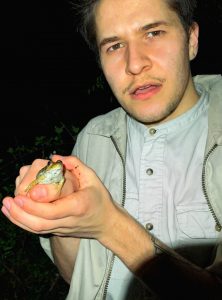
Pavel Pivarshev is a senior majoring in Biology and Visual Arts. He is interested in physiology and evolution in terms of biology, but is also otherwise involved with performance, design, and painting at Duke.
Twitter and Instagram: @peebsbaby
Interviewees

Dr. Jeremy Kiszka, assistant professor of Biological Sciences at Florida International University
Dr. Kiszka is a marine mammologist at Florida International University who studies the ecology of marine megafauna in marine ecosystems.

Robin Winkler, JD
Robin Winkler is a U.S.-born Taiwanese environmentalist who works with the Wild at Heart Legal Defense Association and the Matsu’s Fish Conservation Union in Taiwan.
Series Host
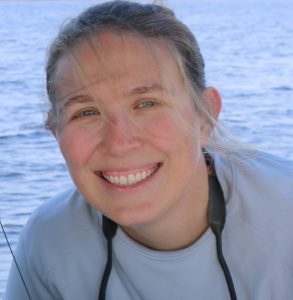
Dr. Reny Tyson Moore host the Whale Pod series. She is a broadly trained interdisciplinary behavioral ecologist with expertise in marine mammal bioacoustics, photographic-identification, population biology, and bio-logging tools and techniques. She is currently a staff scientist with Chicago Zoological Society’s Sarasota Dolphin Research Program and a contractor for NOAA Fisheries Office of Protected Resources through Ocean Associates Inc. Reny received her PhD from Duke University in Marine Science and Conservation, where she used high-resolution acoustic and movement tags to study the fine-scale foraging behaviors of humpback whales along the Antarctic Western Peninsula. Before this, Reny obtained her BSc and MSc from Florida State University where she examined nonlinearites in cetacean vocalizations and determined the abundance and community structure of bottlenose dolphins in the Big Bend of Florida. She went on to apply her skills as a Postdoctoral Research Fellow and Scientific Committee of Antarctic Science Fellow at the Institute for Marine and Antarctic Science, based at the University of Tasmania in Hobart, Australia, and then as a postdoctoral scientist with the Chicago Zoological Society’s Sarasota Dolphin Research Program. Reny has published or been a co-author on many peer- reviewed scientific articles, technical reports, conference papers, children’s books, and conference and workshop presentations. She also serves as a mentor and teacher for undergraduate and graduate students at various institutions, including the Duke University Marine Lab.
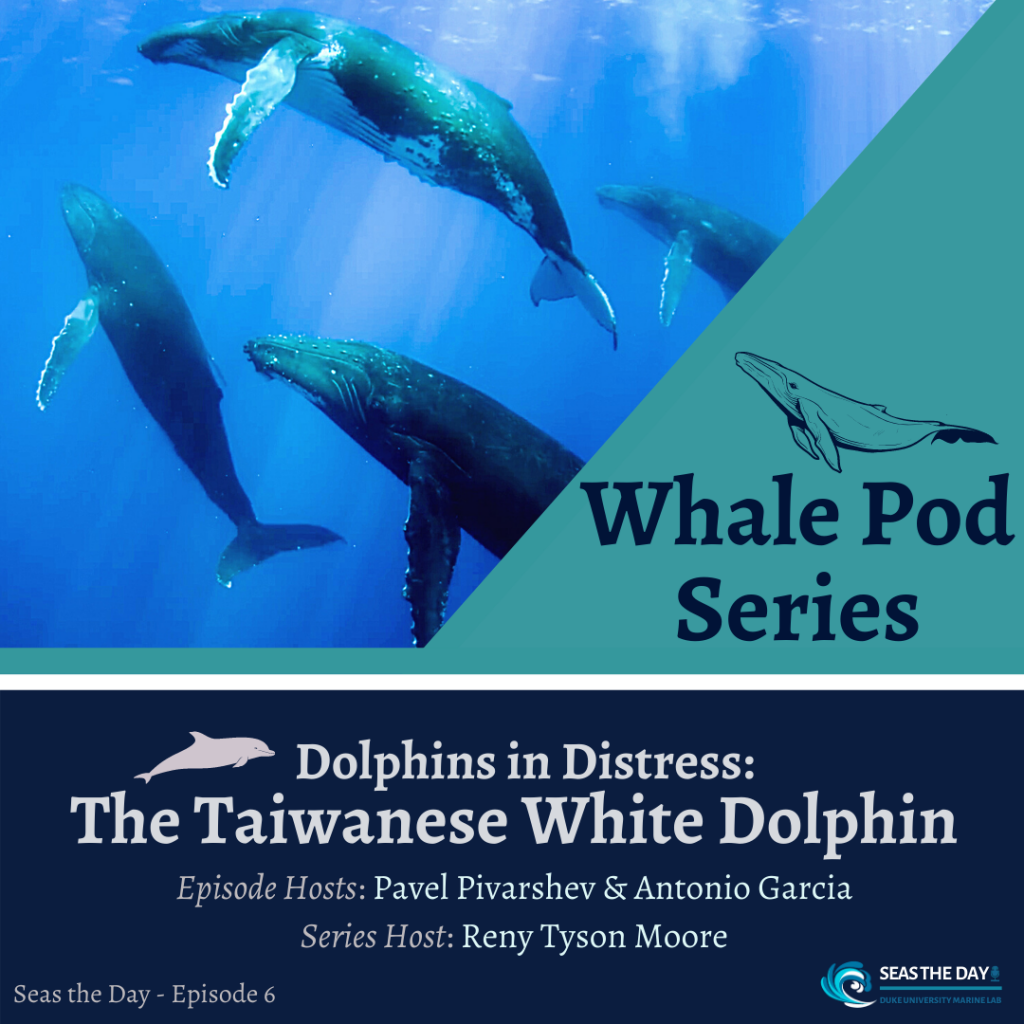
Supplemental material for this episode
Musical interlude
Reny: Hello everyone, and welcome to Seas the Day, a podcast from the Duke University Marine Lab. My name is Reny Tyson Moore, and I will be your host for today as we bring you the first episode from our Whale Pod podcast series. Get it? This series features episodes produced by students who participate in the summer session of my Marine Mammal Science and Conservation course. During the course, students work in teams to produce a podcast episode describing a marine mammal species or stock of their choosing facing a conservation issue or management challenge. This podcast serves as their final term project and allows the students to dig deeper into the topics and issues discussed in class, and those which they may have a particular interest in. One key exciting detail of the project is that each student gets to interview and talk one-on-one with an expert in the field of marine mammalogy about the marine mammal or conservation issue featured in their episode. Another fun part? They get to do all of this in just six short weeks. It’s a whirlwind, but I think the results speak for themselves. This week’s episode focuses on the Taiwanese white dolphin, and it was produced by Duke undergraduate students Pavel Pivarshev and Tony Garcia in the summer of 2020. Pavel and Tony explore the history of humpback white dolphins in Taiwan and assess the threats these small marine mammals are facing, particularly through fisheries interactions. They ask experts from the Wild at Heart Legal Defense Association in Taiwan and Florida International University to weigh in on the magnitude and complexity of these issues, and discuss ways we can all act to protect endangered species such as these charismatic dolphins. We hope you enjoy listening.
Pavel: Hello, and welcome to our podcast. Our names in alphabetical order are Pavel and Tony, and we are undergraduate students in our senior year at Duke University. We are both biology majors and are making this podcast as part of the Marine Mammals course.
Tony: Today we’ll be talking about one of the most captivating conservation topics of the modern day: the story of the Taiwanese white dolphin. It’s a classic tale of pink mammals, environmental threats and hopeful solutions.
Pavel: Featuring interviews with Dr. Jeremy Kiszka at Florida International University and Robin Winkler with Wild at Heart Legal Defense Association in Taiwan.
Tony: Now buckle up and get ready to dive into the world of the Taiwanese white dolphin.
Tony: Picture this: You’re on a trip in Taiwan and are taking a boat tour around the western coast. At first you were hesitant to buy the plane tickets and go on the tour, but you’ve convinced yourself that you deserve it. So there you are, leaning on the railing of the boat, admiring the breeze in the view when you see a glistening pink fin rising from the water. The boat stops, and you admire the dolphins in their natural habitat. Eventually they swim away, and you are back on track with the tour. You’re grateful to have had the chance to see such a fantastic animal. But little do you know if you had waited a few years to visit you may not have seen the Taiwanese white dolphin at all, because it may have been extinct.
Pavel: The Taiwanese white dolphin, Sousa chinensis taiwanensis, is an average-size dolphin endemic to the shallow waters of the West coast of Taiwan. According to a 2015 paper by John Wang in Zoological Studies, it’s a distinct subspecies of the Indo-Pacific humpback dolphin, Sousa chinensis. The subspecies was first described in 2004. A study by Wei-Lun Chang and colleagues in Endangered Species Research which focused on the population’s vulnerability and life history trends concluded that the population growth rate of these Dolphins is remarkably slow. They have calves approximately every 3 1/2 years and each year fewer than three calves survive to the age of 1. As of 2018, fewer than 75 individuals have been recorded in the area.
Kiszka: I’m Dr. Jeremy Kiszka, I’m an assistant professor at Florida International University where I’m the director of the marine conservation ecology lab. So it’s a research lab where we study marine mammals and other large marine creatures in the oceans.
Pavel: So Dr. Kiszka, why is it that we have so many endangered marine mammal species?
Kiszka: Well, coastal species are over-exposed to human activities. I mean, you know along the coast you have most people living on the planet living close to the shores, so you have a whole variety of different impacts that we have on coastal ecosystems that cascade through the food webs. Most threatened species of marine mammals are coastal because it’s where you have disturbance, where you have fisheries, and, you know, bycatch and prey reduction.
Pavel: Right. and the Taiwanese white dolphin is no exception to human threats. We’ll get into the more specific issues impacting the species a bit later.
Tony: In 2008, the International Union for the Conservation of Nature declared the Taiwanese white dolphin critically endangered. Since its discovery, and especially following this assignation, Taiwan has seen lots of activism on the part of non-governmental organizations and legal associations to promote the population’s survival.
Winkler: My name is Robin Winkler, and I’m an American-born Taiwanese, and I was a commercial lawyer doing investment, telecommunications, and intellectual property and so forth for about 20-some years, and then in 2002 I decided to go into… sort of change my clients and do environmental work. I was a member of the environmental impact assessment committee in Taiwan. It’s a committee that reviews all major development projects in Taiwan. And during one of the projects a couple of researchers, it turned out, came in and talked about their work on the Taiwanese white dolphin. So from 2006 one of my colleagues went down, she saw the dolphins, and we’ve been involved with the conservation issues surrounding the Taiwanese white dolphins ever since.
Tony: The population has been placed under the highest category of Taiwan’s Wildlife Conservation Act. The act designates white dolphins as protected wildlife, and states that these animals are not to be disturbed, abused, hunted or killed. Still, despite these protections, dolphins are greatly impacted by human behavior. As of 2018 more than half of the remaining dolphins have received near-fatal injuries from fishing boats and gear. There is also an ongoing wind power project on the coast that threatens the population. How much time can we expect these Dolphins to have before extinction?
Winkler: The Taiwan government’s… the last published annual survey that we’ve seen… for 2019 it showed fewer than 50 animals. Our scientists that we work with believe that it is still 60 to 65, but that’s a very dangerous number. I mean, there is so much activity that’s going on and so much more pressure on the dolphins. This is not a scientific assessment, but in my opinion we’re looking five to ten years.
Pavel: A 2015 paper in the Journal Advances in Marine Biology written by Wang and colleagues explained that the Taiwanese white dolphin faces five major threats to its well-being: habitat degradation, noise pollution, physical pollution, vessel strikes and fisheries bycatch.
Tony: Plenty of marine mammal species face these kinds of threats, but in the case of the Taiwanese white dolphin these stressors are especially dangerous due to the low population count and slow reproduction rate. A lot of these threats arise from the rapid urban development and high human density of Taiwan’s West Coast.
Pavel: The construction of factories, power plants, fishing ports and other industrial infrastructure has changed the coastline throughout the years. In Wang and colleagues’ “Report of the Second International Workshop on Conservation and Research Needs,” the researchers demonstrated that the natural coastline in the area has declined by 20% between 1995 and 2007 as a part of this development.
Tony: The high level of activity also contributes to noise pollution.
Kiszka: What happens is whenever you have so much noise in the water, you have an effect on the behavior of these animals. It creates, like, discomfort, sometimes it can create, you know, direct impact on the body of these animals. In the case of Taiwanese humpback dolphins you have so much disturbance that the animals, you know, just try to move away from these sources. By doing so they’re not doing what they’re supposed to do as dolphins: socially interact, forage, rest, travel from one place to another, so they spend less time foraging which means, you know, less prey intake, decreased body condition and, you know, higher mortality rates.
Pavel: Multiple scientific papers, like Riehl et al 2011 in the Journal of Marine Animals and their Ecology and Yang et al 2013 in the Pakistan Veterinary Journal, have drawn connections between the health of this population and the chemicals related to industry in the region. Many Taiwanese white dolphins are predicted to have dangerous tissue levels of man-made chemicals. Mature male dolphins in particular seem to be at a greater risk of immunotoxicity. There’s also evidence that suggests there are epidermal conditions linked to water salinity, temperature and contaminants.
Tony: According to a 2017 paper by John Wang in Marine Pollution Bulletin, the largest threats to Taiwanese white dolphins by far are fisheries interactions, primarily through vessel strikes and bycatch.
Kiszka: Fisheries affect marine mammals in two different ways. First you have the direct effect of fisheries where fisheries and marine mammals meet and interact physically, so a marine mammal could, you know, be entangled in a line or in a net. So these are, like, what we call the “direct interactions,” or what we call the “operational interactions.”
Tony: Bycatch happens when fishing operations catch something other than the intended species. The Taiwanese government has banned trawling, another dangerous fishing method, within three nautical miles of shore, but activists have recommended a ban on gillnet and trammel net fishing in the area, which contribute to a lot of damage to these dolphins.
Kiszka: On the other hand you have the biological interactions, where fisheries and marine mammals compete for one thing: it’s the resources. So you have a marine mammal population in a given area, and then you have the fisheries. They are not necessarily there at the same time, although most of the time they are, but they just, you know, compete for the same resources. And these are competitive interactions.
Pavel: With the way the Taiwanese government is handling development along its West coast, it doesn’t look like there’s an easy solution in sight. Dr. Winkler has worked directly with Taiwanese officials, so he has an understanding of the government’s priorities when it comes to conservation.
Winkler: The gillnetting that goes on in Taiwan is actually focused right along the western coast in the habitat of the Taiwanese white dolphin, and the government has not been able to persuade the fishers’ association or the fishers that conserving the dolphin is of a benefit to their food chain. So we have to go “OK, so why not?” and so, getting back to the question of “if they’re so protected, why is this all going on?” and I think… I think industrial development is probably the reason. Right now Taiwan is, as I think all countries are, is trying to develop renewable energy, and offshore wind has been brought in as one of the, sort of, saviors of Taiwan’s energy program, because it will be… although the developers are, for the large part, foreign, it will be a domestic source of energy. So that’s where we are right now. And the wind… offshore wind farm developments, surprise surprise, are right in the area where all the gillnets are, and so where all the Taiwanese white dolphins are. So this is going to be 1000 or more very large wind turbines in the Taiwanese white dolphin habitat. I mean, the government is going ahead with conservation programs and is spending some money on that, but at the same time they’re putting multiple times the resources into these energy projects, so I think that that pretty much explains where the government’s priorities are.
Tony: So in such an intense and complicated problem, how do we go about finding and enacting solutions? Conservation is a multi-step process. Conservation scientists like Jeremy can monitor populations in the environment to assess what the impacts are and what actions should be taken to promote the conservation and protection of the ecosystem at hand. Environmental activists like Robin do their part to educate the public as well as policy makers about these issues to make real change. Organizations like the Mazu Fish Conservation Alliance are committed to promoting conservation efforts and facilitating social, economic, and political change. At that point it becomes about putting pressure on the government to enact these policies.
Kiszka: And, you know, although, for example, the society for marine mammalogy have been, you know, expressing some concerns about that subspecies of dolphin, you know, the government would respond “well, yes, we are aware,” and, you know, “we know, and we’re trying to address that,” but we’re not getting any indication of how it is being addressed. So, you know, I think government sometimes… they really need to have, from scientists, packages of solutions. “OK, how do we reduce impact while still, you know, trying to, you know, create richness?”
Pavel: Like many other marine mammals, the Taiwanese white dolphin is considered cute and charismatic. Due to its popularity with the public, the species has become a conservation symbol in Taiwan. Conservationists called this a “flagship species,” and it’s a good tactic for getting people to care about an issue, or multiple issues in the case of preserving an ecosystem.
Tony: The Taiwanese white dolphin is referred to by some locals as the Mazu fish.
Winkler: Mazu is known in Taiwan as the goddess of the sea. There are temples throughout Taiwan and, I understand, southern coastal China, or I think it’s the 23rd of the third lunar month, which is… general equivalent would be about sometime between early March and maybe very early May or late April in the Western calendar, the solar calendar. At that time of the year the waters in coastal Taiwan and coastal China, they settle down, and when you see something white, very likely it’s a Taiwanese white dolphin, or a Chinese white dolphin for that matter. This is Mazu’s fish, they come out to greet her on her birthday. In fact, they’re in the area all year round, they don’t… they are coastal marine mammals, they don’t leave the area, but you can see them much better around her birthday, so that’s Mazu’s fish.
Tony: This cultural significance also plays into the dolphin’s role as a flagship species.
Winkler: So we’re hoping to sort of parlay this… religious fervor into conservation fervor.
Pavel: but even with great non-governmental support and research, getting across to policymakers is a difficult thing to accomplish. For years, the Taiwanese government has not been receptive to the conservationists’ requests.
Tony: One of the big, difficult questions with this topic is “how do you balance economic and industrial development of a big human population with effective, meaningful conservation efforts?”
Winkler: And, you know, one of the things we always point out is “Well, guess what? Ecological, economic, they both “eco” the word for “home,” and what I think has happened is that the folks with the… what I call the “short term” economic priorities have taken control, and basically are running the show. I think it’s really self-evident that when we talk about economics we need to talk about what kind of economics, and if it’s a long-term sustainable economics that we’re talking about, then environmental conservation is a no-brainer. But that extends to taking care of human needs without sacrificing the ability of other species to take care of their needs, much less the human species in generations to come. So that sort of intergenerational justice is applied to inter-species justice, and to me that simply takes care of the whole argument. I no longer refer to my organization as an “environmental protection,” but rather as a “long term economic… sustainable economic advocacy organization,” because I don’t see there’s any inconsistency between a strong economy, a long-term economy, with a healthy social system and a healthy environment.
Tony: Conservationists studying the Taiwanese white Dolphins seem to agree that the best solution is to mitigate the damage caused by industrialization on the West coast. Perhaps the most important action item would be to limit the use of gillnets and trammel nets, but this would have to be done in a way that still preserves the economic prosperity of the region.
Pavel: With all these difficult conversations and approaches to an issue it’s easy to feel hopeless about conservation, but there’s still plenty of success stories to look to for inspiration. Dr. Kiszka, do you have any success stories from your work in conservation biology?
Kiszka: I have a number of success stories, but I would cite one that is really compelling to me. Over the past eight years I’ve been working with the World Wildlife Fund in Pakistan, and this organization has been working on trying to understand the bycatch problem. In the Indian Ocean we estimate that at least 100,000 cetaceans die in gillnets each year, at least in the northern Indian Ocean, particularly tuna drift gillnet fishery. I’m not even talking about all the bottom-set coastal gillnets. So we’ve been working with WWF and they have talked to the fishermen, and they decided to try some mitigation measures. And one mitigation measure that they tried, that is absolutely no cost, and there’s a fleet of about 700 boats in Pakistan, based in Karachi for the most part at the capital, and, you know, they monitored bycatch. They trained the captains to collect data and all that, and, again, you know, they decided to try one mitigation method that has worked in other places around the globe, it’s just lowering the net in the water. So they don’t set the nets that drift, you know, from the surface. They’re just lowered by two meters, 6 feet, and for small cetaceans we realized that it reduces by almost 80% bycatch of dolphins, which is a huge, super exciting result. It’s… it’s a great beginning, you know, and it’s an acceptable mitigation measure for fishermen. But the other very important part of the story is that there is not less tuna caught whenever you lower the net. So yeah, that’s… that’s one of my favorite conservation stories. And actually, we are submitting this story for publication in a scientific journal so it’s… it’s very timely that we talked about it.
Winkler: Yeah, what I would say also is not acting too late means that it’s important to work on species that are not necessarily the most endangered now but in the future that might be.
Tony: So, looking forward, what can scientists and non-scientists without political power do to make the world a better place for endangered species?
Winkler: What people should do, or… other than follow your heart, and the more you get to know nature and the animals and the plants and the fungi and the bacteria and all of that, the more you appreciate it and want to help maintain a balance that humans certainly don’t understand. I think that’s one of our biggest challenges, is to step back from thinking that we’re God and that we know what’s best for these places and get back to being human. And where we can know what’s not good for these places and work with that while maintaining the vision of what we think, you know, is the right way to go. What’s driving these animals to extinction, just stop doing it and start with that premise rather than “Oh, we must have energy, we must have economic… short-term economic growth,” and start bringing our priorities back to “this species is important because it probably… it probably knows something, and we can learn a lot from it.”
Kiszka: We all have a role to play. I think informing and educating people is the number one thing that will solve a huge amount of problems. So we need to educate ourselves first but also spread the word in the most powerful way. And right now we have the technology with social media, that can help, but I think we need to find ways to be even more effective in the way we communicate conservation to the world.
Pavel: So that’s the story of the Taiwanese white dolphin. As you can tell, the battle isn’t over yet.
Tony: If you’re looking to get involved with conservation biology or activism, the first step is to educate yourself on the issues in your community and contribute however you can, whether it’s donating, volunteering, or spreading awareness.
Pavel: And if you want to get involved with the Taiwanese white dolphin in particular, you can visit Wild at Heart’s website at en.wildatheart.org.tw.
Winkler: And it sometimes makes me wonder “why do I do this, why do I spend all this time?” But, you know, you do it because you think it’s a good thing to do. And… as long as there’s dolphins there and people concerned about them, there’s… there’s a little hope.
Musical interlude
Reny: You’ve been listening to Seas the Day, and the first episode in our Whale Pod series. Today’s episode was written and produced by Pavel Pivarshev and Tony Garcia. Brandon Gertz edited the podcast. For more information on our podcast, visit our website, sites.nicholas.duke.edu/seastheday. You can also follow us on Twitter and Instagram at @seasthedaypod. Our theme music was written and produced by Joe Morton. Our artwork is by Stephanie Hillsgrove. Jeff Priddy provides us with technical support. If you enjoyed today’s episode, please share it with a friend. Thanks for listening.
Chang, Wei-Lun, S.L. Huang, & L. Karzmarski. (2014). Population trends and vulnerability of humpback dolphins Sousa chinensis off the west coast of Taiwan. Endangered Species Research 26:147-159. https://doi.org/10.3354/est00619.
Chang, W., Karczmarski, L., Huang, S., Gailey, G., & Chou, L. (2016). Reproductive parameters of the Taiwanese humpback dolphin ( Sousa chinensis taiwanensis ). Regional Studies in Marine Science, 8, 459-465. doi:10.1016/j.rsma.2016.08.001
Riehl, K.N., S.Z. Dungan, A. Wee, J. Wang. (2011). A review of the impacts of anthropogenic activities on the critically endangered eastern Taiwan Strait Indo-Pacific humpback dolphins (Sousa chinensis). Journal of Marine Animals and Their Ecology 4(2):3-9.
Wang, John, S.C. Yang, S.K. Hung. (2013). Diagnosability and description of a new subspecies of Indo-Pacific humpback dolphin, Sousa chinensis (Osbeck, 1765), from the Taiwan Strait. Zoological Studies 54(36). doi:10.1186/s40555-015-0115-x.
Wang, J. Y., Riehl, K. N., Klein, M. N., Javdan, S., Hoffman, J. M., Dungan, S. Z., . . . Araújo-Wang, C. (2016). Biology and Conservation of the Taiwanese Humpback Dolphin, Sousa chinensis taiwanensis. Advances in Marine Biology Humpback Dolphins (Sousa Spp.): Current Status and Conservation, Part 2, 91-117. doi:10.1016/bs.amb.2015.07.005
Wang, J. Y., Riehl, K. N., Yang, S. C., & Araújo-Wang, C. (2017). Unsustainable human-induced injuries to the Critically Endangered Taiwanese humpback dolphins ( Sousa chinensis taiwanensis ). Marine Pollution Bulletin, 116(1-2), 167-174. doi:10.1016/j.marpolbul.2016.12.080
Yang, WC, WL Chang, KH Kwong, YT Yao, & LS Chou. (2013). Prevalence of epidermal conditions in critically endangered Indo-Pacific humpback dolphins (Sousa chinensis) form the waters of Western Taiwan. Pakistan Veterinary Journal. Pakistan Veterinary Journal, 33(4):505-509.

